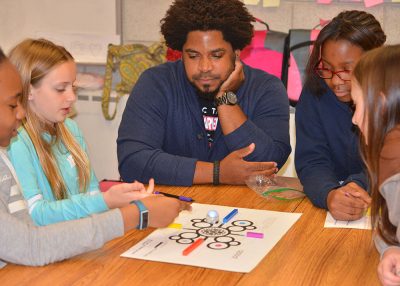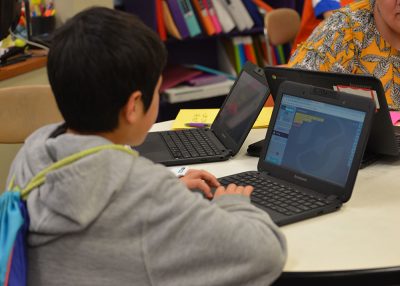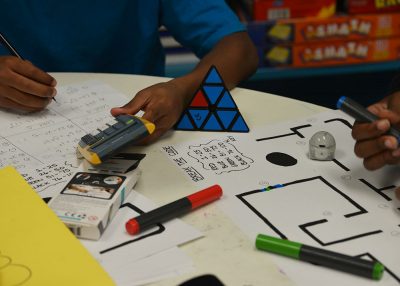Editor’s Note: Applications for the 2020 Rogers Fund will open in mid-September. Learn more about the Rogers Educational Innovation Fund.

Dwight Sharpe, recipient of the Neag School’s Rogers Educational Innovation Fund in 2018, has always been intrigued by science and technology.
“Being able to play with things and understand how things work,” Sharpe says, is what engaged him as a child; remote-controlled cars were among his favorite toys. “That’s the tie between mathematics and technology: recognizing there is so much math that goes into creating these electronic-type devices.”
At Woodrow Wilson Middle School in Middletown, Conn., where he was teaching math in 2017, Sharpe had come across some robots stored in the school’s technology office, which sparked an idea: using robots in the classroom.
With this in mind, he applied for the 2018 Rogers Educational Innovation Fund, a $5,000 award designated by Neag School Professor Emeritus Vincent Rogers and his late wife, Chris, in support of innovative projects carried out by Connecticut teachers at the elementary or middle-school level.
Sharpe’s project, entitled “Accessing and Engaging in Mathematics Through Robotics and Computer Programming,” seeks “to explore and determine how robotics and computer programming can be embedded into middle school instruction to improve student engagement and achievement.” It was selected from among more than 40 submissions.
“At the end of the day, the new project was about engagement. It was about integrating something into the classroom that hasn’t been there.”
— Dwight Sharpe, 2018 Rogers Award Recipient
New Technology Leads to New Approach
“As an eighth-grade mathematics teacher at Woodrow Wilson Middle School, I often find it difficult to actively engage my struggling learners so that they are able to master mathematical concepts,” Sharpe had explained in his original project proposal.
This year, in an effort to improve mathematics performance for all students, Sharpe has been collaborating with his grade-level colleagues and curriculum supervisor to provide more personalized instruction to students. In Middletown, elementary schools are in their fourth year of implementing Guided Math implementation, an approach that allows small groups of students situated around the classroom to work together on specific curriculum standards. The schools have seen a positive impact on student mastery and performance measures as a result of this approach to math instruction; Woodrow Wilson Middle hopes to replicate this success with their own implementation of Guided Math.
“Because many students have not had significant success in mathematics classes and assessments, they have developed a fixed mindset in which they believe they cannot independently solve mathematical problems without the scaffolding and support from me,” Sharpe says. “Many students are disengaged, frustrated, and unwilling to take risks in the classroom that allow for learning and success.”
While the classroom model at the school had long centered on students sitting at their desks while teachers lectured, Sharpe saw an opportunity to transform that with his robotics and computer programming project.
“At the end of the day, the new project was about engagement,” he says. “It was about integrating something into the classroom that hasn’t been there.”
Instead of the teacher speaking in front of the classroom, there are now stations throughout the classroom where students can teach themselves or learn and discover on their own. By integrating robotics and computer programming into math instruction through Guided Math groups, Sharpe seeks to motivate students to apply mathematical concepts.
“My intention was to find out if there was something we could bring into the classroom that’s going to get the kids engaged, that’s going to be more on the level of what they want to learn,” Sharpe says.

Robots and Probots and Ozobots – Oh My
In each unit of study, Sharpe has created a variety of hands-on lessons and activities integrating specific types of small robots or robotic platforms — among them Ozobots, Probots, Spheros, and Bloxels — that allow students to apply mathematical concepts they have studied.
“I will ask students to collaborate to solve problems, articulate their solutions, and demonstrate their understanding,” Sharpe says.
For example, students can use Ozobots to demonstrate the relationships expressed by the Pythagorean Theorem; engage with ProBots to plot the answers to basic equations of lines and planes; or develop video games based on specific mathematical skills using a platform called Bloxels — all of which Sharpe says can help make math lessons “a lot more appealing to kids.”
“Success in these activities will also help students to develop a mathematical mindset in which they believe they are capable of mastering math concepts through collaboration, questioning, and problem solving,” he says. “Because the need and ability of my students vary significantly in the classroom, I have deliberately identified four robotic devices that will allow me to differentiate activities so that I can meet students where they are and allow for growth.”
Ultimately, Sharpe says he hopes “students will not only come to class excited to participate in mathematics, [but also] believe that they can succeed.”

Opening Doors
Once the new equipment was brought into classrooms, many students were eager to play and experiment with it. “It was really awesome to have various stations with all the computers going, and the kids bumping into each other,” says Sharpe.
Yet some students – and even some teachers – were anxious about the new tools.
“For something new to come in, especially for a lot of kids, change isn’t always easy,” admits Sharpe, who says he had to think through the new curriculum to figure out a more interdisciplinary approach to math instruction.
Soon enough, math seemed to become more accessible among the different students in the classroom, especially female students. Sharpe recalls one such student in eighth grade who was struggling with learning coding. Sharpe spent time with her, helping her to understand the concepts. “I was coaxing her through, saying … ‘I think you are downplaying your ability and doing something that someone told you you cannot do’,” he says.
A few weeks later, he reconnected with the student, whose attitude had completely changed. “‘This coding stuff is awesome’,” Sharpe recalls her saying. “‘You were right. I was thinking that I couldn’t do it, when actuality I really could.’”
The hands-on-experience and exposure to the various types of robots, Sharpe says, are “opening doors” for many different students.
What’s Next
Over the next year, the school will look to incorporate the robots very intentionally into the project-based learning, and to identify the data and see how the project has helped improve student learning and performance in various tests.
Sharpe says he thinks the students are “having an understanding of the application of math and knowing that if ‘I input something that I then get a result back’; I think that conceptual understanding of mathematics is huge.”
Though he has begun serving in a new role, as the district equity, restorative practices, and social-emotional learning facilitator for Middletown (Conn.) Public Schools, Sharpe will continue to champion the project.
“There are so many things changing in the math department, I feel like I’m missing so much,” he says. “I try to sneak into math classes as much as possible.”
Thanks to the generosity of Vincent and Chris Rogers, the project has the funding needed to pave a new way of thinking, Sharpe says, allowing students to “think beyond just the normal,” to think creatively, and to look at things differently.
It “really gives the kids the insight to what is possible, even if you can’t see it in front of you,” he says.
Check out more information about the Rogers Educational Innovation Fund. Applications for the 2020 Rogers Fund will open in mid-September.
 Facebook
Facebook
 Twitter
Twitter
 LinkedIn
LinkedIn
